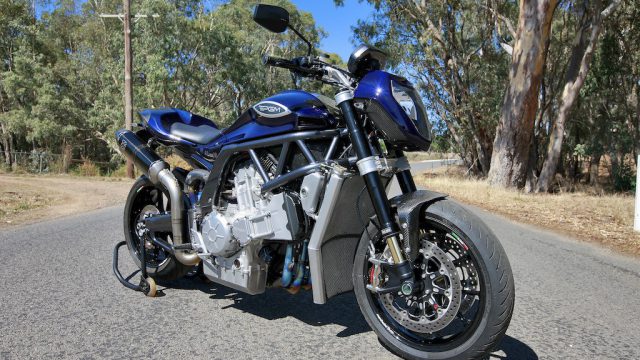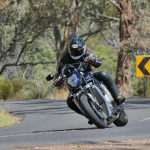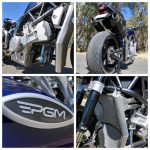Full inside story and hands-on road test of the Australian-built 2000cc V8 Streetfighter developed in secret over a seven-year period, and now available for customer purchase
As New Year’s Day messages go, looking ahead to the promise of a freshly dawned year, this one took some beating. Scorching through cyberspace from the other side of the world, it got my attention straight away just from the subject heading: ‘PGM V8, 334HP, 2.0 litre V8 Motorcycle!’ Attached were three photos of an über-muscular looking V8 streetfighter well-finished enough to have plausibly been produced by any major manufacturer, together with a spec sheet that seemed too good to be true. “I’d like to invite you to be the first person outside our development group to experience the PGM V8 next time you visit Australia,” said the message, signed by a guy named Paul Maloney. Now, where have I heard that name before – oh, yes, wasn’t he the Aussie bloke who worked for Harald Eckl’s team ten years ago, and used to build the factory Kawasaki Superbike and MotoGP race engines? I met him once when I tested the bikes at Zeltweg – but it can’t be the same fellow, can it? But there again, it is a small world….

Two months later almost to the day I rumbled back into Maltec Performance Engineering’s HQ in the Victorian Goldfields with a broad smile on my face after a day spent riding the single most impressive piece of multi-cylinder madness I think I’ve ever had the privilege of sampling. Just check out that spec sheet if you think I’m exaggerating, for the PGM V8 I’d just spent the day riding was dyno tested to deliver 334 bhp at the rear wheel at 12,800 rpm, with 214 Nm of torque at 9,500 revs. Yet it has a clutch light enough to work with a single finger, on a bike that’s a pussycat prowling round town at low speeds, before shaking off that disguise in a flash to become the Lion King of the highway once you show it an open road, and work its ride-by wire/RBW throttle hard. But just make very, very sure you hold on very, very tight when you do so – because with a ‘mere’ 242kg kerb weight to make motion aboard, fully fuelled with 16.5 litres in the gas tank, the PGM V8 is the closest thing to riding a drag racer on the street I’ve yet encountered – and that includes my own supercharged Vee Two Super Squalo V-twin once-a-Ducati, which with ‘only’ 204 bhp at the rear wheel is practically wimpish compared to the PGM V8. Funnily enough – that was Made in Australia, too….

Australia – the can-do country, a nation where problems are opportunities, adversity a challenge, and a glass is always half full, rather than half empty. It’s a place where people don't wonder IF they can overcome any problems or difficulties, only HOW that can be done. So when expat Aussie MotoGP race engineer Paul Maloney – for it was indeed him – decided on returning home after 20 years spent working in Europe’s MotoGP and Superbike paddocks to build the V8 streetfighter he’d had the idea for rolling around in his mind for the past decade or more, he went ahead and did it – just like that. Moreover, he did so without word getting out that this bloke in Victoria was building a V8 streetfighter or something. How come?
Conceived as a pair of Yamaha R1 motors mounted on a common crankcase, with the advantages of performance coupled with reliability this entails
“During my time in Europe I spent a lot of time criss-crossing the continent in a truck, and in particular when I was working with [Swedish Superbike champion] Christer Lindholm,” said Paul as we sipped a cuppa tea in the late afternoon sunshine on the patio of his house in the Victoria Goldfields northwest of Melbourne. “It would take us 45 hours of driving to get from Stockholm down to Spain, and nothing ever stopped us apart from tanking up with diesel. I had a lot of time to think, and while we were trundling along the road I came up with the idea for this bike. I’m sure I’d seen Ian Drysdale’s V8 at this stage [another product of Melbourne’s mafia of mechanical free-thinkers, built less than 100km from the PGM HQ – AC], but for a long, long time I’d had this idea of building a V8 myself, using Yamaha R1 cylinders and heads.

But I first made all the drawings using 750 Kawasaki parts because the ZX-7RR had separate cylinders, and that made the crankcase so much simpler – the early Yamaha R1 had a closed deck cylinder block. So I first drew it up as a 1500cc motor based on two 750 Kawasakis, because I had access to the parts at Harald Eckl’s where I was then working. But then right when I was about to start building it, out came the 2004 Yamaha R1 with separate cylinders. So I checked the measurements and even with 2000cc it was going to be no wider, so from that point onwards I was always going to use Yamaha stuff because of my previous ten-year background in Yamaha. But it wasn’t till I came back here to Australia from Europe that I could get stuck into it – and what you’ve just been riding is the result!”

And what a result that is. It’s hard to over-emphasise how thoroughly practical and totally rideable in real world conditions the PGM V8 is, for apart from its undoubted massive visual presence, you have no inkling of its seemingly limitless performance when you climb aboard, turn on the ignition, fire it up and move off, rejoicing as you do so in the fantastic – no other word for it – aria issuing from the twin separate Akrapovič 4-2-1 exhausts. And that’s only at low speeds – get it revving hard and the sound is literally awe-inspiring, both to onlookers and the person fortunate enough to be sitting aboard it, and making that music via his right hand. I’ve ridden several variants of the equally remarkable smaller-capacity Drysdale V8 in both 750cc and 1000cc form, and while his 750-V8 Superbike that raced in Australian endurance events back in the late ‘90s was also pretty musical, none of the others have delivered the same kind of aural concerto as the PGM V8.

The riding position on the Maloney V8 proved unexpectedly accommodating, too, in spite of the seat having to be positioned above the vertically-mounted rear bank of cylinders. But at 840mm/33in. in height it’s not excessively tall, and neither is the PGM V8 overly wide compared to a normal motorcycle, even with what amounts to a Yamaha R1 cylinder head positioned between your knees where it straddles the frame – and offset slightly to the left, at that. The carbon fibre shroud covering the left end of that rear cylinder head does its job well in acting as a heat shield, and my Kushitani leather jeans didn’t get cooked by the motor, any more than the legs inside them – the riding position has been really well thought out.
Modular chassis sees tubular steel spaceframe attached to aluminium rear spars with Öhlins monoshock operated by bell-crank link, and Öhlins aftermarket Ducati Diavel fork
OK, it’s slightly wider than a conventional bike, but it’s not something you’re aware of once under way, provided you keep up any kind of momentum. Because of the extra bulk of the V8 motor it does seem a little ungainly at low speeds, though, and making a U-turn can be quite fraught if you’re not careful, plus at rest I could put just the toes of both feet on the ground at once – and at 1.80m/5’10” in height I’m not excessively short. That, and the slightly brusque pickup from a closed throttle which is surely just a question of fuel mapping, were the only criticisms I had of a bike which otherwise seems incredibly refined and improbably well developed for the product of a single dedicated engineer and a bunch of mates, working in a small workshop out in the bush. Just amazing.

That applies as much to the PGM V8’s appearance as to its dynamics, for designer Seanr Chhean’s styling gives the bike an integrated, sophisticated appearance that’s all of a piece rather than a collection of parts that happened to find themselves combined together to form a motorcycle. There’s a pleasant visual flow to the carbon fibre seat and tank unit – actually, a shroud hiding the metal fuel tank – and the V8 motor is undeniably handsome-looking, with serious visual presence yet an aura of refinement that’s worthy of a mainstream manufacturer. The quality of finish is superlative, well worthy of a motorcycle of this calibre and price level – and in case you wondered, the PGM V8 is indeed ready for production and will be produced to order, in limited numbers, with prices starting at US$180,000, depending on specification. Contact Paul Maloney on www.pgmv8.com.au if you’d like to learn more.

That sense of refinement is reinforced when you get the show on the road, for the PGM V8 is extremely easy to ride at what I’ll term normal speeds – it’s perfectly at home pootling lazily through towns in third gear at 40mph/60kph, with no spitting back through the throttle bodies or popping back through the exhaust in disdain at being forced to ride so comparatively slowly. But then show it an open stretch of highway, and the colossal reserves of performance come swiftly to the fore once you wind the engine up above the 5,000 rpm mark as shown on the fabulously easy to read and informative dash display that is a model to other manufacturers – why can’t they all be as easy to decipher at a glance as this one is, and especially the big green gear selected reading that really stands out, next to the large white digital speed icon that’s equally legible?
Melbourne-made one-piece flat-plane crankshaft carries Yamaha R1 conrods and pistons
You’ll be glad of that to keep track of momentum once you open the taps on the PGM V8, for wound up hard its acceleration is PHENOMENAL – nothing else I’ve ever ridden with lights and a licence plate comes close to matching the effortless sweep of forward motion the PGM V8 delivers at literally the twist of a wrist! It’s not explosive, neither is it aggressive, just completely effortless and totally irresistible, as if it’s a force of nature that it’s pointless to withstand. I have a feeling that few if any of today’s MotoGP bikes would be able to keep up with this motorcycle in a straight line, for as the old adage goes, there’s no replacement for displacement – or put another way, no substitute for cubes….

Yet in spite of being so unbelievably fast accelerating, the Aussie V8 is all so controllable in the way it delivers its humungous performance. It doesn’t try to loop the loop and flip you off the back like a similarly mega-torquey E-bike will do if you don’t treat its throttle with great respect. Paul Maloney had dialled in a 10,500 rpm limiter on the RBW digital throttle for my test – the bike was just 1,500km from new, remember – rather than the 14,500 rpm redline he believes it’ll be safe to in due course, but that was more than enough to deliver a passable imitation of that contradiction in terms – a landlocked guided missile that simply rockets forward once you metaphorically light the blue touch paper, and hold on tight. VERY tight….

The PGM’s flat one-piece handlebar bolted to the tall, gracefully fluted risers incorporated in the upper triple clamp, between which nestles the compact rotary steering damper, gives good leverage in hustling the PGM through a sequence of tight turns out in the bush, but also delivers a riding position which has you inclined slightly forward to load up the front wheel with your body weight as a matter of course. This isn’t as tiring as I expected it to be, and is certainly a help in countering wheelies, which because of its effortless rather than explosive acceleration the PGM V8 was curiously reluctant to pull as a matter of course. The rangy 1550mm wheelbase helps here, naturally, without at the same turning this über-powerful streetfighter into a truck in the twisties. OK, it’s not exactly a Supersport 600 in the way it goes round turns – but neither is it something you have to manhandle through a sequence of corners. I was pleasantly surprised how much fun the PGM V8 was to ride through the twisties, and Paul Maloney has used his Superbike setup experience well in dialling in the Öhlins suspension just right for the bumpy but grippy road surfaces out in the Goldfields. And the Brembo brakes delivered the kind of much needed stopping power from warp factor speeds that massage your confidence in riding the bike. They’re just what you need to haul down a 330bhp motorcycle from the speeds it can deliver. And plaudits too for the gearbox shift action, which is flawless and fully Japanese quality in spite of having had to be re-engineered in Australia. It’s a job done well.

And that applies to the whole PGM V8 package, which after riding it I can say more than lives up to first impressions as a poised yet purposeful and ultra-potent package, that deserves to find discerning customers around the world with sufficiently healthy bank balances to purchase the entry ticket to owning the world’s most exclusive and fastest accelerating customer motorcycle. Look, a Yamaha VMAX is positively second division by comparison, with a mere 147kW/200bhp and 166.8 Nm of torque on offer in a bike that outscales the Aussie V8 at 310kg wet loaded with 15 litres of gas. Yet in many ways, what's most impressive about the PGM V8 is that this is the product of one man's personal drive and technical inventiveness. Paul Maloney had the vision to single-mindedly conceive the V8 bearing his initials, and to work away in secret for seven long years to create it. But now it’s here, it’s deeply impressive and ultra-thrilling to ride – and it’s absolutely Australian.
















